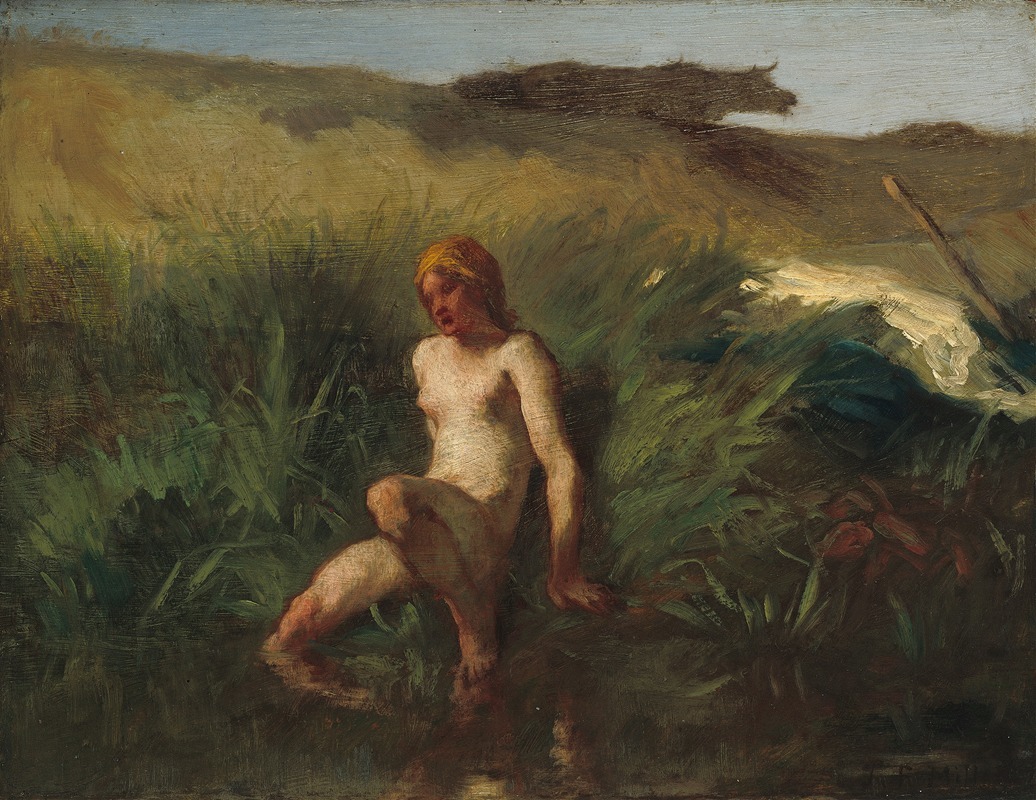
The Bather
A hand-painted replica of Jean-François Millet’s masterpiece The Bather, meticulously crafted by professional artists to capture the true essence of the original. Each piece is created with museum-quality canvas and rare mineral pigments, carefully painted by experienced artists with delicate brushstrokes and rich, layered colors to perfectly recreate the texture of the original artwork. Unlike machine-printed reproductions, this hand-painted version brings the painting to life, infused with the artist’s emotions and skill in every stroke. Whether for personal collection or home decoration, it instantly elevates the artistic atmosphere of any space.
Jean-François Millet, a prominent French painter and one of the founders of the Barbizon School, is renowned for his depictions of peasant life and rural scenes. One of his lesser-known works is "The Bather," which reflects his interest in the human figure and the natural environment. Although not as famous as some of his other paintings like "The Gleaners" or "The Angelus," "The Bather" provides insight into Millet's artistic style and thematic concerns.
"The Bather" was created during a period when Millet was deeply engaged with the rural landscape and the lives of the people who inhabited it. His work often focused on the dignity and hardship of rural laborers, and he was known for his ability to capture the essence of the human condition through his art. In "The Bather," Millet shifts his focus slightly to explore the human form in a more intimate and personal setting.
The painting depicts a solitary figure, a bather, in a natural setting. Millet's use of light and shadow, as well as his attention to detail, brings a sense of realism and immediacy to the scene. The figure is rendered with a sense of solidity and presence, characteristic of Millet's style, which often emphasized the physicality and earthiness of his subjects. The natural environment surrounding the bather is depicted with a similar attention to detail, highlighting Millet's appreciation for the beauty and complexity of the natural world.
Millet's approach to the human figure in "The Bather" is consistent with his broader artistic philosophy. He believed in the importance of depicting subjects truthfully and with empathy, avoiding idealization or romanticization. This philosophy is evident in "The Bather," where the figure is portrayed with a sense of authenticity and respect. The painting reflects Millet's commitment to capturing the everyday realities of life, even in moments of solitude and introspection.
While "The Bather" may not be as widely recognized as some of Millet's other works, it nonetheless contributes to our understanding of his artistic legacy. The painting exemplifies his skill in rendering the human form and his ability to convey the quiet dignity of his subjects. It also underscores his interest in the interplay between humans and their natural surroundings, a theme that recurs throughout his oeuvre.
Millet's work, including "The Bather," had a significant influence on later artists, particularly those associated with the Realist and Impressionist movements. His focus on ordinary people and everyday scenes helped pave the way for a more democratic approach to art, where the lives of common people were deemed worthy of artistic representation. This shift in focus resonated with many artists who followed, contributing to the evolution of modern art.
In summary, "The Bather" by Jean-François Millet is a testament to the artist's skill in depicting the human figure and his commitment to portraying the realities of life with honesty and empathy. Through this work, Millet continues to be celebrated for his contributions to the art world and his influence on subsequent generations of artists.


















